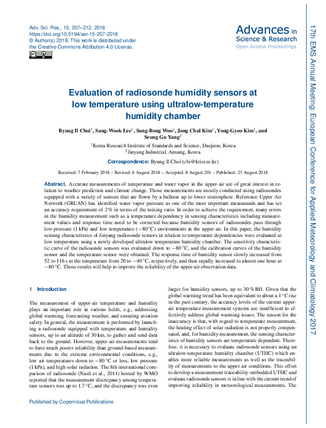Title
Evaluation of radiosonde humidity sensors at low temperature using ultralow-temperature humidity chamber
Authors
Choi, B. I., Lee, S.-W., Woo, S.-B., Kim, J. C., Kim, Y.-G., and Yang, S. G.
Published
by Advances in Science and Research (ASR) at 2018-08-23
Abstract
Accurate measurements of temperature and water vapor in the upper-air are of great interest in relation to weather prediction and climate change. Those measurements are mostly conducted using radiosondes equipped with a variety of sensors that are flown by a balloon up to lower stratosphere. Reference Upper Air Network (GRUAN) has identified water vapor pressure as one of the most important measurands and has set an accuracy requirement of 2% in terms of the mixing ratio. In order to achieve the requirement, many errors in the humidity measurement such as a temperature dependency in sensing characteristics including measurement values and response time need to be corrected because humidity sensors of radiosondes pass through low-pressure (1 kPa) and low-temperature (−80 ∘C) environments in the upper-air. In this paper, the humidity sensing characteristics of Jinyang radiosonde sensors in relation to temperature dependencies were evaluated at low temperature using a newly developed ultralow-temperature humidity chamber. The sensitivity characteristic curve of the radiosonde sensors was evaluated down to −80 ∘C, and the calibration curves of the humidity sensor and the temperature sensor were obtained. The response time of humidity sensor slowly increased from 52 to 116 s at the temperature from 20 to −40 ∘C, respectively, and then rapidly increased to almost one hour at −80 ∘C. Those results will help to improve the reliability of the upper-air observation data.
Citation
Choi, B. I., Lee, S.-W., Woo, S.-B., Kim, J. C., Kim, Y.-G., and Yang, S. G.: Evaluation of radiosonde humidity sensors at low temperature using ultralow-temperature humidity chamber, Adv. Sci. Res., 15, 207–212, https://doi.org/10.5194/asr-15-207-2018, 2018.
